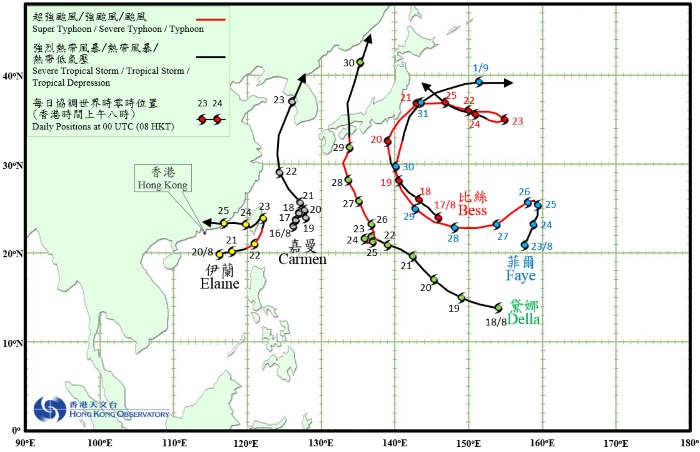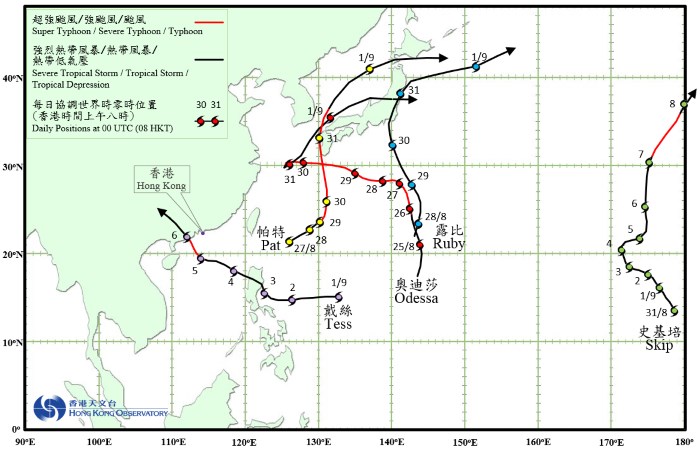Occurrence of Multiple Tropical Cyclones
21 September 2016
Tropical cyclone development over the western North Pacific and the South China Sea was rather active in August 2016 with a number of tropical cyclones forming during the month. At one time on the morning of 20 August, there were four cyclones (Dianmu, Mindulle, Lionrock and Kompasu) in co-existence over the basin.
According to the Observatory's records since 1960, cases with three tropical cyclones co-existing over the western North Pacific and the South China Sea can be found nearly every year. Cases of four tropical cyclones occurring at the same time were less frequent with only four cases since 2000 as detailed in the table below:

The highest number of tropical cyclones in co-existence in this basin is five. It happened twice, in 1960 (Figure 1) and 1985 (Figure 2). On the morning of 23 August 1960, Elaine was over the sea areas east of Taiwan, Carmen to the west of the Korean Peninsula, and Della, Faye and Bess over the western North Pacific. Elaine edged towards the coast of Guangdong after moving across Taiwan, necessitating the hoisting of Standby Signal No. 1 in Hong Kong. On the morning of 1 September 1985, Odessa and Pat were over the Sea of Japan, Ruby east of Japan, Tess east of the Philippines, and Skip near the International Date Line. Tess eventually entered the South China Sea and intensified into a typhoon, passing within 200 km southwest of Hong Kong and necessitating the issuance of the Gale or Storm Signal No. 8.

Figure 1Tracks of Bess, Carmen, Della, Elaine and Faye in 1960

Figure 2Tracks of Odessa, Pat, Ruby, Skip and Tess in 1985
Given that tropical cyclones typically require a separation spacing of 10 - 15 degrees to develop, and in terms of longitude the basin of western North Pacific and South China Sea has a span of about 80 degrees from west to east (100oE to 180o), there is probably a reason why the maximum number of co-existing tropical cyclones so far is five. Although six is not impossible, but we will have to wait and see.
C.W. Choy and M.C. Wu
According to the Observatory's records since 1960, cases with three tropical cyclones co-existing over the western North Pacific and the South China Sea can be found nearly every year. Cases of four tropical cyclones occurring at the same time were less frequent with only four cases since 2000 as detailed in the table below:

The highest number of tropical cyclones in co-existence in this basin is five. It happened twice, in 1960 (Figure 1) and 1985 (Figure 2). On the morning of 23 August 1960, Elaine was over the sea areas east of Taiwan, Carmen to the west of the Korean Peninsula, and Della, Faye and Bess over the western North Pacific. Elaine edged towards the coast of Guangdong after moving across Taiwan, necessitating the hoisting of Standby Signal No. 1 in Hong Kong. On the morning of 1 September 1985, Odessa and Pat were over the Sea of Japan, Ruby east of Japan, Tess east of the Philippines, and Skip near the International Date Line. Tess eventually entered the South China Sea and intensified into a typhoon, passing within 200 km southwest of Hong Kong and necessitating the issuance of the Gale or Storm Signal No. 8.

Figure 1Tracks of Bess, Carmen, Della, Elaine and Faye in 1960

Figure 2Tracks of Odessa, Pat, Ruby, Skip and Tess in 1985
Given that tropical cyclones typically require a separation spacing of 10 - 15 degrees to develop, and in terms of longitude the basin of western North Pacific and South China Sea has a span of about 80 degrees from west to east (100oE to 180o), there is probably a reason why the maximum number of co-existing tropical cyclones so far is five. Although six is not impossible, but we will have to wait and see.
C.W. Choy and M.C. Wu